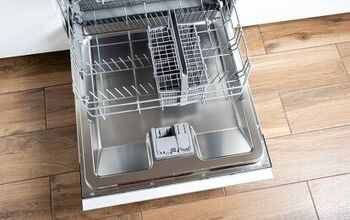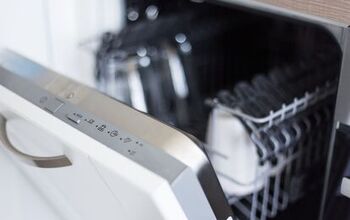Dishwasher Float Not Operating Properly? (Possible Causes & Fixes)

Dishwashers are useful appliances that have been around for decades. They make hand-washing dishes look inefficient, and they’ve only gotten better with the passage of time. These days, dishwashers are equipped with all kinds of high-tech features and components, and such explains why modern dishwashers are, for the most part, so reliable.
But dishwashers, like all other appliances, don’t stay in good condition forever, which means eventually repair work will be needed. One thing that can happen to a dishwasher is its float not working properly. The float is an important part of the dishwasher, and this article will explain what causes a float to not work properly as well as what to do when the float is malfunctioning.
If your dishwasher’s float is not working properly, it could be dirty. There could also be something wrong with the guide tube. If a dishwasher float’s stem is warped or bent, this could be the problem. When the dishwasher float doesn’t work properly, the system might fill up with too much water. A professional can fix the float.
Do You Need Appliance Repair Services?
Get free, zero-commitment quotes from pro contractors near you.

What Is a Dishwasher Float?
The float is the component in the dishwasher that prevents too much water from entering the basin of the dishwasher. Once there is an adequate amount of water, the float—which rises with the water—will rise and stop the water intake valve from pumping more water.
The float will work as it’s supposed to most of the time, but sometimes food particles and other debris can’t prevent the float from working as it’s supposed to. To remedy this situation, all that’s required is simple cleaning. Here’s what you need to do:
Cleaning the Dishwasher Float
First, disconnect your dishwasher from its power supply. You can unplug the system, remove the corresponding fuse from the fuse box, or turn off the appropriate circuit breaker.
Next, you should open the dishwasher and remove the lower dish rack. If the dishwasher utilizes a stationary float cover, you’ll need to remove this; it’ll either be a snap-on cover or something that utilizes a screw.
Now it’s time for cleaning. With a toothbrush and a warm water-detergent mix, gently scrub the float so that there’s no buildup anywhere. You’ll also want to scrub around the area nearby the float. Once the float is rid of all buildup, grime, and food particles, it should operate correctly again.
Testing the Float
When cleaning isn’t enough to fix your dishwasher’s float, then you should test this component to see what happens. You should lift the float up and let it drops several times. When you do this, the float should move freely in the guide tube.
If there’s any kind of restriction, try to identify what’s causing the restriction and, if it’s possible, remove this. A dishwasher float may lift out of the guide tube easily or there may be a retainer attached to its stem; a stem is there to prevent the component from being dislodged.
If there is a retainer present, you’ll need to remove this first. You can do this by removing the lower access panel; this is just held in place with a few screws. Once that’s removed, you can detach the retainer and see what’s going on with the guide tube.
If you find debris, clean it out, and then check the stem itself to make sure there are no malfunctions there. If you find that the stem is warped or damage, then you’ll need to have this replaced. There may also be an instance when you need to replace both the float assembly and the retainer.
Additional Float-Related Problems
If any wires or hoses are impeding the movement of the float or the float switch, you should get these out of the way. Once you think the problem has been resolved, lift up the float again to see if it goes back into place freely. If it does, all you need to do now is replace the float cover.
Once your system is working properly again, put the lower dish rack back in and restore power. Now you can really test your system to see if the float is working as it should. If the problem is fixed, all that’s left is replacing the access panel.
If you have a problem beyond this point, it could have to do with the float switch or the water inlet valve. To address either of these components, you should get in touch with a professional plumber or a technician who can service your dishwasher.
What Happens When a Float Malfunctions?
If there’s something wrong with the inlet valve, you could mistake this for being a dishwasher float problem. The water inlet valve is what provides a steady stream of water into your dishwasher, and when this component begins to malfunction, then there’s a good chance your dishwasher won’t fill with water properly.
To fix this issue, you need to first inspect the water inlet valve. This is located behind the kickplate panel at the bottom of the appliance. There is a hose connected to it, as this is what brings the water into the dishwasher.
First, look at the hose and see if there are any loose connections or kinks; either could cause a problem with the unit’s water supply. You should also check the valve’s filter screen, as this could get clogged and then prevent water from getting inside the dishwasher.
You may not be able to inspect the dishwasher’s water inlet valve on your own, so when this happens, it’s best to get help from a certified and trusted appliance repair expert. They’ll know how to fix your system no matter what’s wrong with it, and if replacement is the only solution, they’ll be straightforward about this.
You May Have a Malfunctioning Door Switch
A malfunctioning dishwasher door can also cause the system to not work properly. For example, your dishwasher may not fill with water as it should if the door is not shut correctly, and a malfunctioning door can also impede your appliance’s sensor from distinguishing open from closed.
The first thing you should do when you suspect there’s a door-related problem is look at the door gasket and see if it’s properly installed. The next thing you should do is see if there’s a tight seal where the dishwasher door meets the rest of the appliance.
At this point, you should locate the door switch, and which is located in the dishwasher control panel; if you need to inspect this, you can easily remove the panel. Use a multimeter to test the door switch. If you don’t know how to do this, get somebody who does.
Do You Need Appliance Repair Services?
Get free, zero-commitment quotes from pro contractors near you.

Related Questions
Does a dishwasher float need a cover?
While the float doesn’t need a cover to operate, you don’t want to run the dishwasher in this way because the float will be over-exposed to food and other damaging particles. If you have a simple snap-on cover, then there shouldn’t be too much hassle.
Screwing and unscrewing a float cover can be more tedious. In any case, the dishwasher float cover serves a necessary purpose, so you really should not operate your system without one.
Can you replace a dishwater water inlet valve DIY?
The water inlet valve is an integral part of a dishwasher for all the reasons explained above. Unless you know how to work with this component, you should refrain from doing so.
Instead, get help from a professional. After all, you may need replacement, and only someone who knows what they’re doing will be able to tell you this. A dishwasher working without a proper water inlet valve is like a car running without an engine—it’s just not going to happen.

Matt loves everything DIY. He has been learning and practicing different trades since he was a kid, and he's often the first one called when a friend or family member needs a helping hand at home. Matt loves to work with wood and stone, and landscaping is by far his most favorite pastime.
More by Matthew Mountain



























